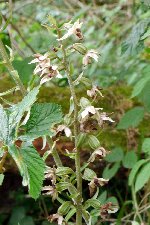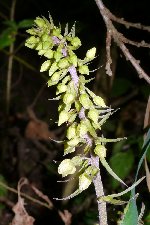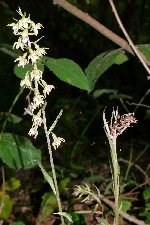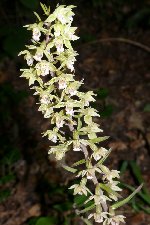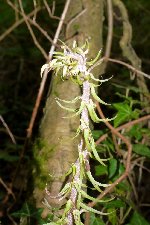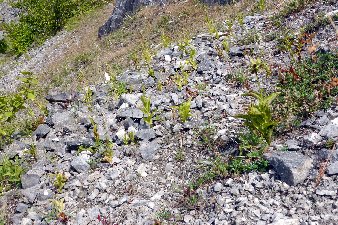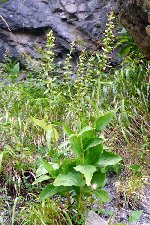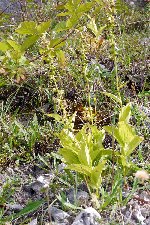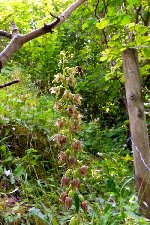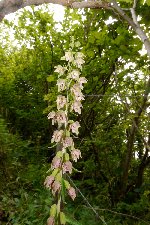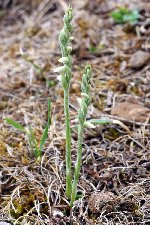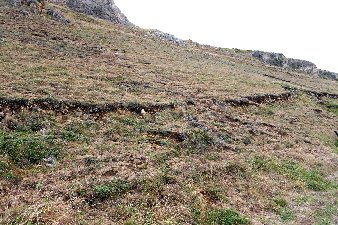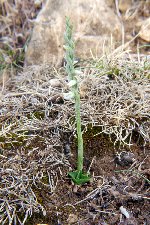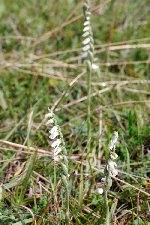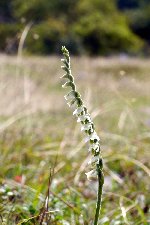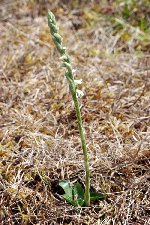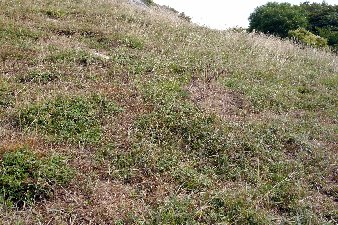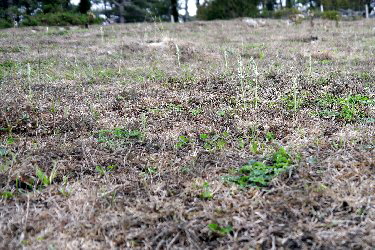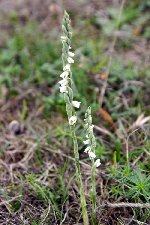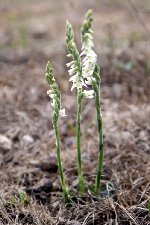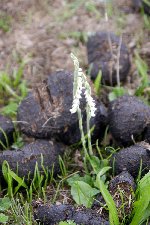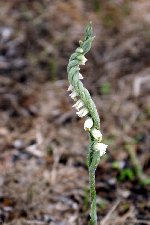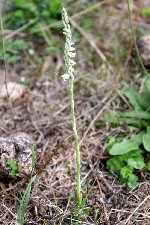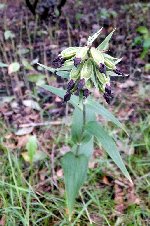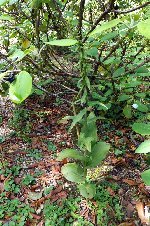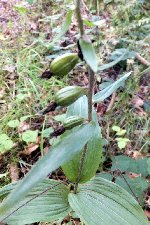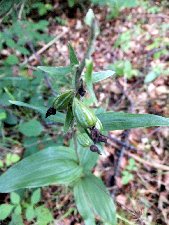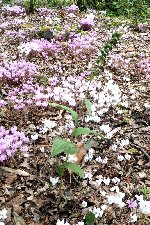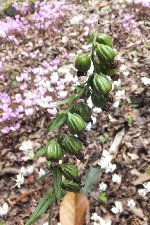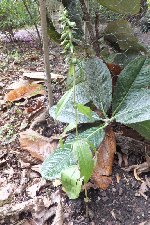|
|
|||||||||||||||||
|
|
|||||||||||||||||
 |
|
Severn Valley Country Park, 3rd August 2018 (SO 748 838) This site this year is full of contrasts. We first look at the scrub near the Severn where the very pale flowered Violet Helleborines grow, and find a few of them, but they are nearly over. Then in the woods there are some plant some days off opening. There are other plants in full flower and looking good, and others that have suffered from the heat and drought - right next to each other. One spike catches my eye. No flowers, and seemingly extra brats. Is this some sort of deformed flower, or have the buds been dropped during the heat? The former is most likely as the abnormal weather is making other plants shrivel. We do find more plants in a strip of woodland across the railway line, so the colony is bit more extensive than it seems. In total, including shriveled plants, we counted 31. Others were probably there but hidden under the other undergrowth. Minera Quarry, 4th August 2018 (SJ 25156 52172) An earlier visit here would have been a real treat, but the Broad-leaved Helleborines growing beneath the rock face are virtually finished, and the seed pods are starting to swell. This area is quite an unusual habitat; basically waste crushed limestone acting as scree. There is no shade, and the ground does slope quite a bit. However, the text books do give a mention of such a habitat as being a suitable one. Here, though, the plants on the scree look quite different to those in the shade. The leaves are keeled and bright apple green, with the flowers quite pale. Under the trees the flowers are more pigmented while the leaves are flatter and a deeper green. Is this an eco-type phenomena, or has a certain clone been selected as being suitable for growing the open? Great Orme, 23rd August 2018 (SH 77023 82312) September has arrived early this year. I've never seen the Autumn Lady's-tresses in flower during August before, but this year they could well be over by the time the ninth month starts. Here the ALTs are scattered along the path on the Orme side, but this year they are more numerous. I count 100 spikes. The July drought has affected the site. The grass has not recovered yet, with any green vegetation being deeper rooted flowering plants. However, the ALTs seem to have benefitted from the weather. Little Orme, 23rd August 2018 (SH 81319 82125) At the other end of Llandudno Bay lies the Great Orme's younger twin. The Autumn Lady's-tresses like the south facing slopes, so the footpath starting where the road passes by looks the place to go. We find some 50 in flower, which is a good count from past experience at other sites. There are some nice tall specimens if 7-8cm can be considered tall. With the grass here also affected by lack of rain we can see some plants have next year's rosette starting to appear. Gop Hill, 23rd August 2018 (SJ 08790 80005) We have saved the best for last! We have been here before for the Autumn Lady's-tresses, and seen a scattering of them above the quarry. This year though, there are thousands of them just about everywhere above a certain elevation. It seems that the unusual weather this year has benefitted ALTs not only in north Wales, but many other areas too. It will be interesting to see if these numbers return next and subsequent years. This does raise the question of whether we usually miss seeing a lot of flowers, or are these from seeds from a few years ago and in their first season flowering. If so that means our normal weather results in many potential flowers not making it. It is amazing that from the evidence on the ground that a number of horses graze here yet the ALTs are not eaten or trampled. Perhaps the orchids are protected. Hare Hill Gardens, 25th August 2018 (SJ 87816 76749) and Alderley Edge (SJ 85790 77270) On a National Trust day out in Cheshire we come across a few Epipactis plants well past flowering and will ovaries swelling. Those at Hare Hill Gardens were growing along the path edge behind the walled garden, and at Alderley Edge they grew actually on the roadside as well in a bit of mixed woodland. The evidence points to them being Broad-leaved Helleborines. The habitat is typical, the stems are `hairy', and they are known to grow in the woods at nearby Alderley Park. Worth looking for if your are visiting at flowering time, but not worth a special visit - blink and you could miss `em! Hodnet Hall Gardens, 27th August 2018 (SJ 60872 28437) Another gardens and another Broad-leaved Helleborine spotting. This time it is slap bang in the middle of a bed of cyclamen, and almost certain not weeded out by the ground staff. A look around the immediate area, especially at the back of the flower bed, put the total count to a round dozen. They all showed swelling seed pods. Each time this species has been found in gardens (here, Hare Hill, Eaton Hall, Bodnant) they have been growing in beds where they will not be disturbed; not in the `woodland walks'.
|
|
|
||||||||||||||||||||
